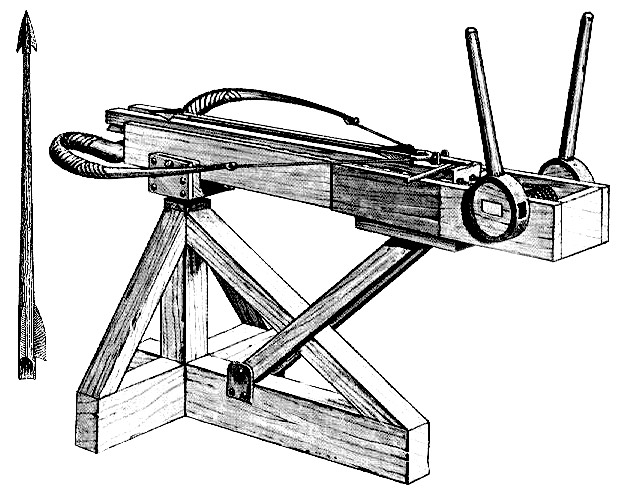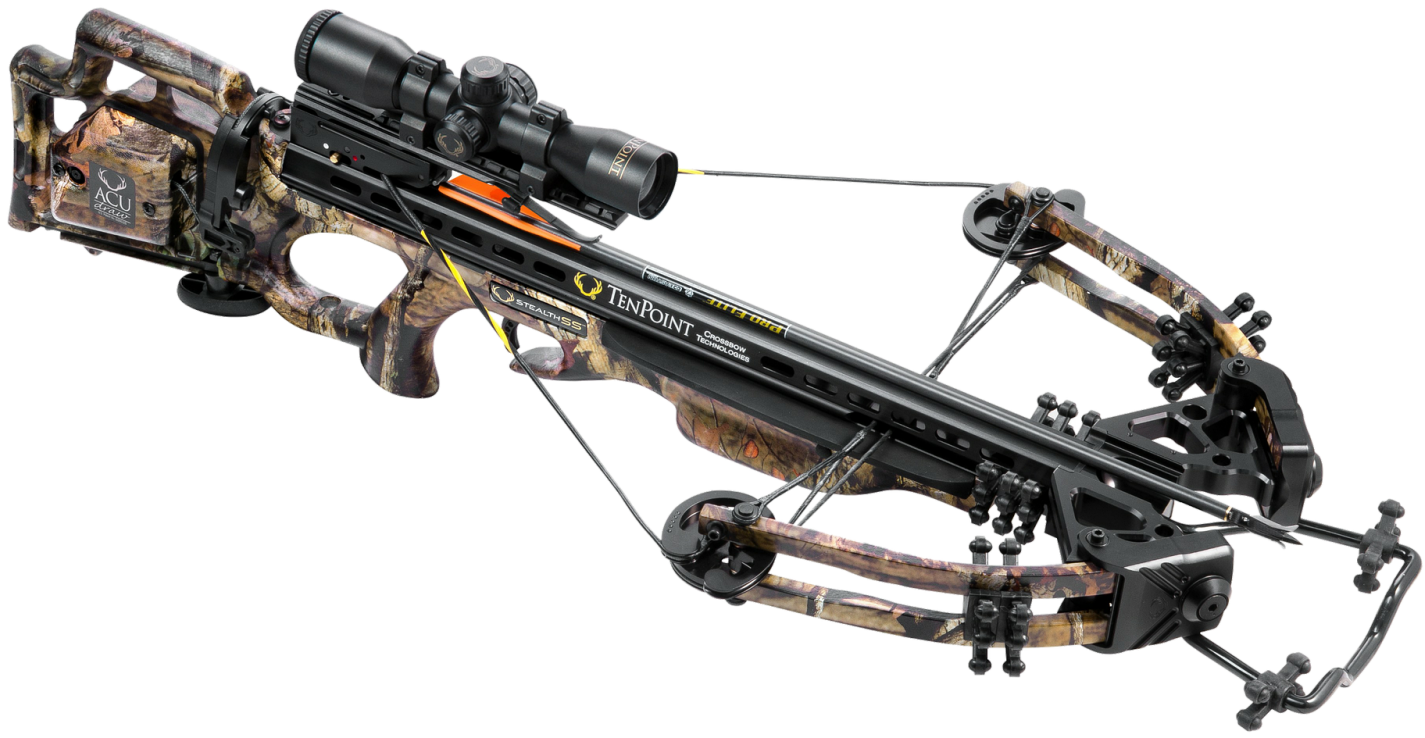|
Ballista
The ballista (Latin, from Ancient Greek, Greek βαλλίστρα ''ballistra'' and that from βάλλω ''ballō'', "throw"), plural ballistae or ballistas, sometimes called bolt thrower, was an Classical antiquity, ancient missile weapon that launched either Crossbow_bolt, bolts or stones at a distant target. Developed from earlier Greek weapons, it relied upon different mechanics, using two levers with torsion springs instead of a tension prod (the bow part of a modern crossbow). The springs consisted of several loops of twisted Hank (textile), skeins. Early versions projected heavy dart (missile), darts or spherical stone projectiles of various sizes for siege warfare. It developed into a smaller precision weapon, the ''Scorpio (weapon), scorpio'', and possibly the ''polybolos''. Greek weapon The early ballistae in Ancient Greece were developed from two weapons called oxybeles and gastraphetes. The gastraphetes ('belly-bow') was a handheld crossbow. It had a composite p ... [...More Info...] [...Related Items...] OR: [Wikipedia] [Google] [Baidu] |
Scorpio (weapon)
The ''scorpio'' or scorpion was a type of Roman torsion siege engine and field artillery piece. It was described in detail by the early-imperial Roman architect and engineer Vitruvius in the 1st century BC and by the 4th century AD officer and historian Ammianus Marcellinus. Ammianus Marcellinus, Roman History' Design Two versions are known: a horizontal two-armed variety like a ballista and a one-armed, vertical version otherwise referred to as an ''onager''. The scorpion was made of a ground frame made of two beams joined together with crossbeams. Spring holes were drilled into the sides of the beams to allow for ropes to be placed in, thus allowing them to serve as sinew-springs. This gave the weapon more power. An arm made of wood known as the ''stilus'', with iron hooks at the end, was used to hold the stone or bolt which was to be fired. The fourth century army officer and historian Ammianus Marcellinus witnessed the use of ''scorpiones'' during several engagements ... [...More Info...] [...Related Items...] OR: [Wikipedia] [Google] [Baidu] |
Oxybeles
The oxybeles () was a weapon used by the Ancient Greeks starting in 375 BC. The word is derived from Ancient Greek: οξύς (''oxys'' = sharp, pointed) and βέλος (''belos'' = arrow). The weapon was basically an oversized gastraphetes, a composite bow placed on a stand with a stock and a trigger. It was supplanted by the scientifically engineered ballista. The difference between the two is the use of torsion power by the ballista. The most notable use of the oxybeles was under Alexander the Great's rule. See also * Ballista * Gastraphetes * Scorpio (weapon) The ''scorpio'' or scorpion was a type of Roman torsion siege engine and field artillery piece. It was described in detail by the early-imperial Roman architect and engineer Vitruvius in the 1st century BC and by the 4th century AD officer an ... Notes References *Duncan B. Campbell and Brian Delf, ''Greek and Roman Artillery 399 BC–AD 363'', New Vanguard series 89, Osprey Publishing Ltd., Oxford 2003. *J ... [...More Info...] [...Related Items...] OR: [Wikipedia] [Google] [Baidu] |
Crossbow
A crossbow is a ranged weapon using an Elasticity (physics), elastic launching device consisting of a Bow and arrow, bow-like assembly called a ''prod'', mounted horizontally on a main frame called a ''tiller'', which is hand-held in a similar fashion to the stock (firearms), stock of a long gun. Crossbows shoot arrow-like projectiles called ''crossbow bolt, bolts'' or ''quarrels''. A person who shoots crossbow is called a ''crossbowman'', an ''arbalister'' or an ''arbalist (crossbowman), arbalist'' (after the arbalest, a European crossbow variant used during the 12th century). Crossbows and bows use the same elastic launch principles, but differ in that an archer using a Bow and arrow, bow must draw-and-shoot in a quick and smooth motion with limited or no time for aiming, while a crossbow's design allows it to be spanned and cocked ready for use at a later time and thus affording them unlimited time to aim. When shooting bows, the archer must fully perform the bow draw, draw, h ... [...More Info...] [...Related Items...] OR: [Wikipedia] [Google] [Baidu] |
Second Punic War
The Second Punic War (218 to 201 BC) was the second of Punic Wars, three wars fought between Ancient Carthage, Carthage and Roman Republic, Rome, the two main powers of the western Mediterranean Basin, Mediterranean in the 3rd century BC. For 17 years the two states struggled for supremacy, primarily in Roman Italy, Italy and Iberia, but also on the islands of Sicily and Sardinia and, towards the end of the war, in North Africa. After immense materiel and human losses on both sides, the Carthaginians were once again defeated. Macedonia (ancient kingdom), Macedonia, Kingdom of Syracuse, Syracuse and several Numidians, Numidian kingdoms were drawn into the fighting, and Celtiberians, Iberian and Gauls, Gallic forces fought on both sides. There were three main Theater (military), military theatres during the war: Italy, where Hannibal defeated the Roman legions repeatedly, with occasional subsidiary campaigns in Sicily, Sardinia and Greece; Iberia, where Hasdrubal (Barcid), Hasdru ... [...More Info...] [...Related Items...] OR: [Wikipedia] [Google] [Baidu] |
Alexander The Great
Alexander III of Macedon (; 20/21 July 356 BC – 10/11 June 323 BC), most commonly known as Alexander the Great, was a king of the Ancient Greece, ancient Greek kingdom of Macedonia (ancient kingdom), Macedon. He succeeded his father Philip II of Macedon, Philip II to the throne in 336 BC at the age of 20 and spent most of his ruling years conducting Wars of Alexander the Great, a lengthy military campaign throughout West Asia, Western Asia, Central Asia, parts of South Asia, and ancient Egypt, Egypt. By the age of 30, he had created one of the List of largest empires, largest empires in history, stretching from History of Greece, Greece to northwestern History of India, India. He was undefeated in battle and is widely considered to be one of history's greatest and most successful military commanders. Until the age of 16, Alexander was tutored by Aristotle. In 335 BC, shortly after his assumption of kingship over Macedon, he Alexander's Balkan campaign, campaigned in the Bal ... [...More Info...] [...Related Items...] OR: [Wikipedia] [Google] [Baidu] |
Polybius
Polybius (; , ; ) was a Greek historian of the middle Hellenistic period. He is noted for his work , a universal history documenting the rise of Rome in the Mediterranean in the third and second centuries BC. It covered the period of 264–146 BC, recording in detail events in Italy, Iberia, Greece, Macedonia, Syria, Egypt and Africa, and documented the Punic Wars and Macedonian Wars among many others. Polybius' ''Histories'' is important not only for being the only Hellenistic historical work to survive in any substantial form, but also for its analysis of constitutional change and the mixed constitution. Polybius' discussion of the separation of powers in government, of checks and balances to limit power, and his introduction of "the people", all influenced Montesquieu's '' The Spirit of the Laws'', John Locke's '' Two Treatises of Government'', and the framers of the United States Constitution. The leading expert on Polybius for nearly a century was F. W. Walbank (1909 ... [...More Info...] [...Related Items...] OR: [Wikipedia] [Google] [Baidu] |
Hecht 090710 Ballista
Hecht may refer to: * Hecht (surname) * Hecht, a pop rock band from Lucerne, Switzerland. * Hecht's, a chain of department stores, also known as Hecht Brothers, Hecht Bros. and the Hecht Company * Hecht Museum at Haifa University in Israel * ''Hecht'' (submarine), a German World War II two-person submarine * Wolfpack Hecht ("Pike"), a group of German World War II U-boats * Hecht is a gymnastics dismount skill performed on the horizontal bar or uneven bars The uneven bars or asymmetric bars is an artistic gymnastics apparatus. It is made of a steel frame. The bars are made of fiberglass with wood coating, or less commonly wood. The English abbreviation for the event in gymnastics scoring is UB or ... * Hecht vault, a type of vault in gymnastics See also * Justice Hecht (other) {{disambiguation ... [...More Info...] [...Related Items...] OR: [Wikipedia] [Google] [Baidu] |
Universal Joint
A universal joint (also called a universal coupling or U-joint) is a joint or coupling connecting rigid shafts whose axes are inclined to each other. It is commonly used in shafts that transmit rotary motion. It consists of a pair of hinges located close together, oriented at 90° to each other, connected by a cross shaft. The universal joint is not a constant-velocity joint. U-joints are also sometimes called by various eponymous names, as follows: * Cardan joint, after Gerolamo Cardano, a polymath of the 16th century who contributed to knowledge of various clever mechanisms, including gimbals * Hooke joint or Hooke's joint, after Robert Hooke, a polymath of the 17th century who contributed to knowledge of various clever mechanisms * Spicer joint, after Clarence W. Spicer and the Spicer Manufacturing Company, who manufactured U joints * Hardy Spicer joint, after the Hardy Spicer brand, a successor to the Spicer brand History The main concept of the universal joi ... [...More Info...] [...Related Items...] OR: [Wikipedia] [Google] [Baidu] |
Siege Tower
A Roman siege tower or breaching tower (or in the Middle Ages, a belfry''Castle: Stephen Biesty's Cross-Sections''. Dorling Kindersley Pub (T); 1st American edition (September 1994). Siege towers were invented in 300 BC. ) is a specialized siege engine, constructed to protect assailants and ladders while approaching the defensive walls of a fortification. The tower was often rectangular with four wheels with its height roughly equal to that of the wall or sometimes higher to allow archery, archers or crossbowmen to stand on top of the tower and shoot arrows or quarrels into the fortification. Because the towers were wooden and thus flammable, they had to have some non-flammable covering of iron or fresh animal skins. Evidence for use of siege towers in Ancient Egypt and Anatolia dates to the Bronze Age. They were used extensively in warfare of the ancient Near East after the Late Bronze Age collapse, and in Egypt by Kingdom of Kush, Kushites from Sudan who founded the Twenty-fifth ... [...More Info...] [...Related Items...] OR: [Wikipedia] [Google] [Baidu] |
Bal BBC1
Bal or BAL may refer to: People * Bal (surname), including a list of people with the name * Bal (given name), including a list of people with the name Places * Bal, Iran (other), several places * Bal, Zira, Punjab, India * Bäl, Gotland, Sweden Science Medicine * Bio-artificial liver, a bioartificial liver device * Blood alcohol content * Bronchoalveolar lavage, a diagnostic method of the lower respiratory system * British anti-Lewisite, or Dimercaprol, a medication to treat acute poisoning * Cholate—CoA ligase, or bile acid CoA ligase (BAL), an enzyme Computing * IBM Basic Assembly Language and successors * Business application language Transportation * Balham station, London, England, station code BAL * Ballarat railway station, Australia * Baltimore Penn Station, Baltimore, Maryland, US, AMTRAK code BAL * Batman Airport, Batman, Turkey, IATA airport code BAL * BAL, abbreviation of the now-defunct Russian airline, BAL Bashkirian Airlines * BAL, the p ... [...More Info...] [...Related Items...] OR: [Wikipedia] [Google] [Baidu] |






